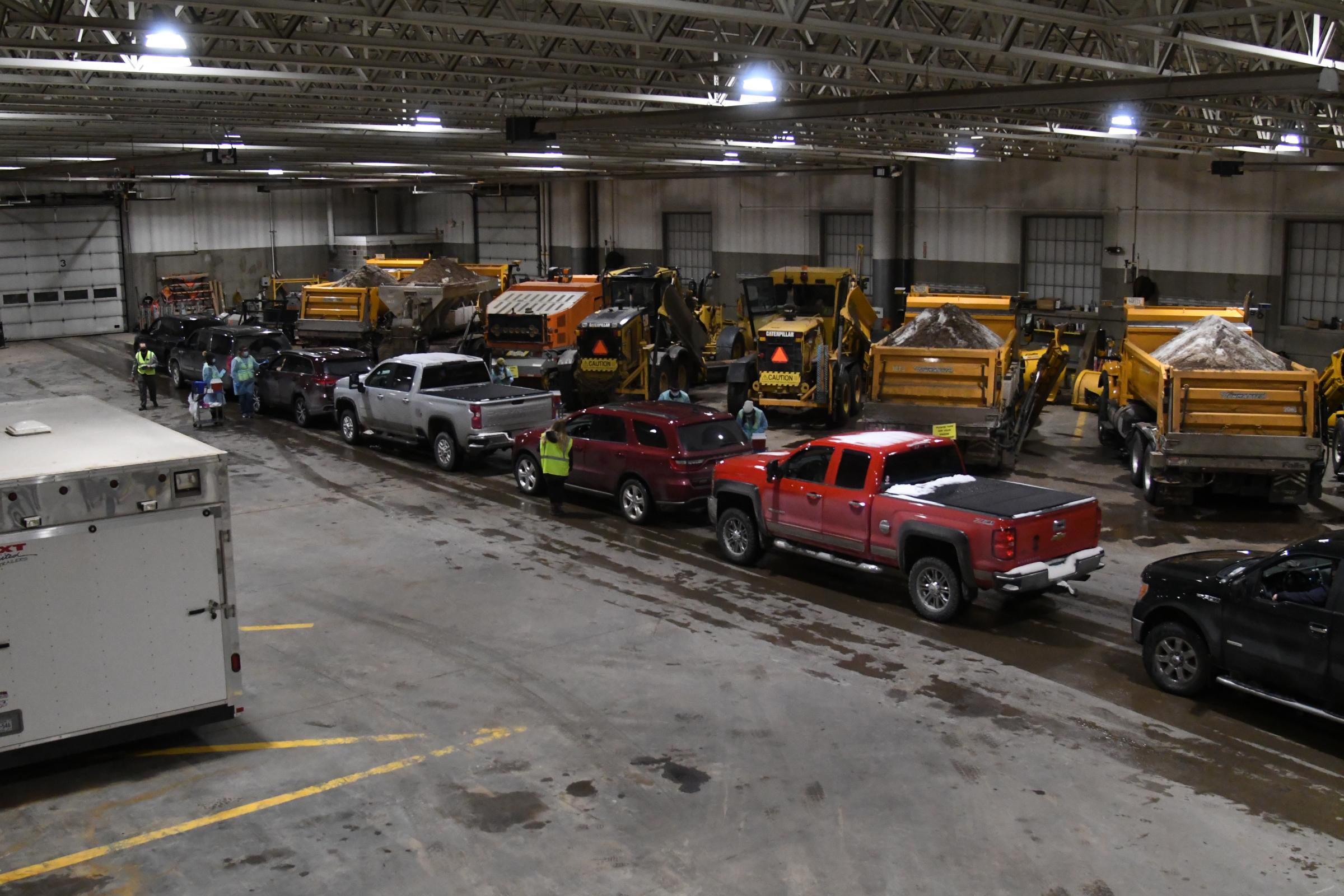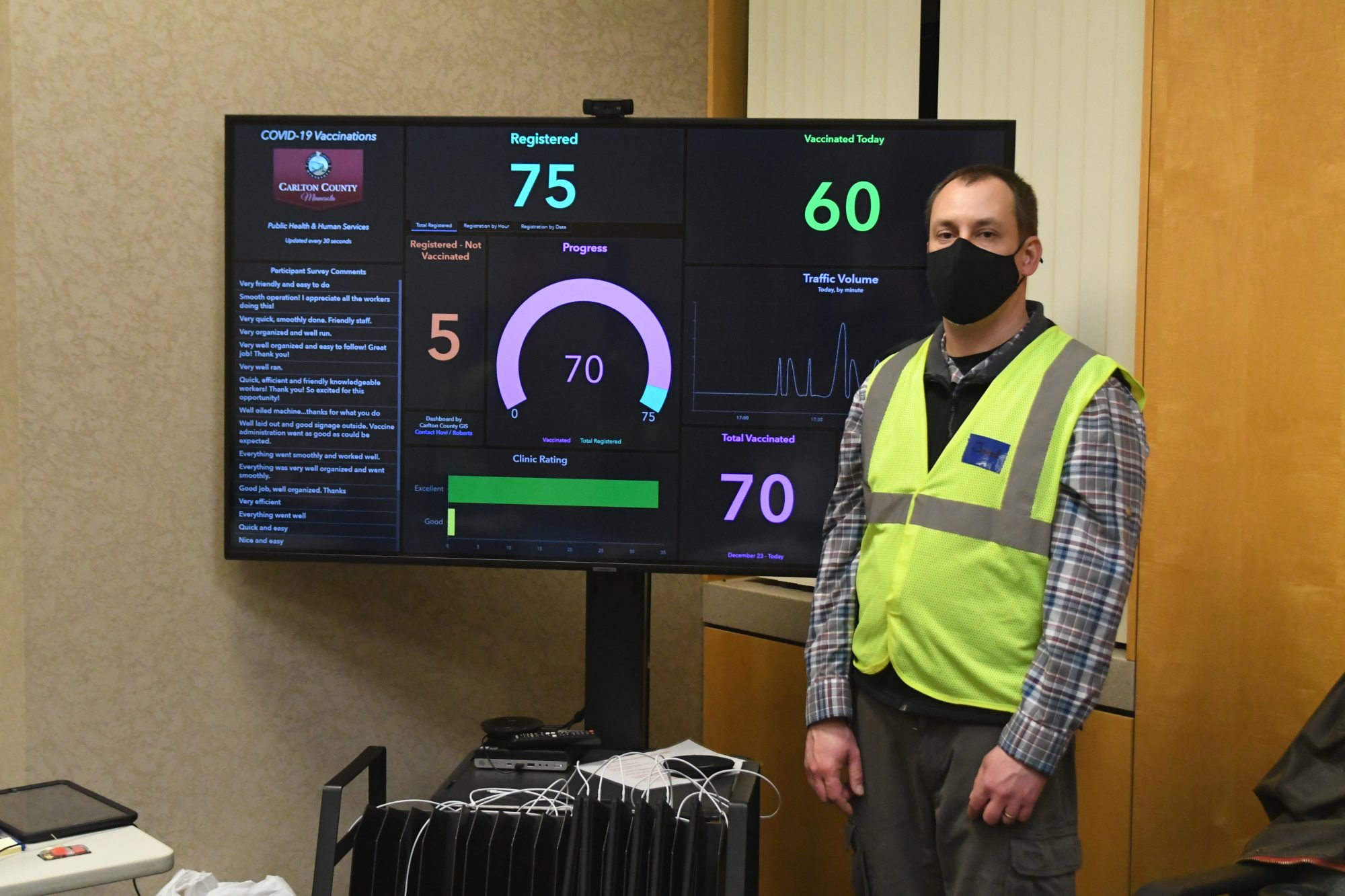Even though the COVID-19 vaccine clinic wasn’t due to open until 5 p.m., cars started lining up around about 15 minutes early, just as darkness, and some snowflakes, started to fall. The vehicles, some ambulances and other types of emergency response cars, belonged to 70 first responders in Minnesota’s Carlton County who wanted to be among the first in the area to get vaccinated against COVID-19. They drove through the large parking garage in Carlton, run by the county’s transportation department, where they received one of the northern Minnesota county’s allotment of 100 doses of the vaccine made by Moderna, from the state’s initial batch of 15,000 doses.
The county, located just beyond the western tip of Lake Superior, is home to about 35,000 people, and is among the first around the country to use a drive-through strategy for vaccinating its residents against COVID-19; Hamilton County in Tennessee held its first day of a two-day drive-through vaccination clinic for health care workers and first responders on the day after Christmas, and had to close before its second day because of overwhelming demand. Health officials in Macon in Illinois, are planning its drive-up immunization on Dec. 30, and Florida’s Brevard County is holding its first drive-through COVID-19 vaccination clinic on Jan. 4 for those over age 65.
Carlton County’s emergency preparedness team was ready for the line of first responders waiting, in their cars, for their shots. The county team had been preparing for this evening since last summer, when it started thinking about how best to fulfill its pending task of vaccinating all of the county’s residents when a COVID-19 shot became available. “One of the main responsibilities of public health departments is to dispense vaccines and medications, especially during a public health emergency,” says Ali Mueller, emergency preparedness coordinator for the county. “But we knew with COVID-19 that mass dispensing of vaccines would have to be done in a different way; the in-person setup in large conference rooms or schools, and having long lines with people in close proximity, wouldn’t be possible [because of the risk of spreading the virus.]”
Over the summer, when a local clinic offered drive-through immunizations for kids who had missed their well-child visits, it sparked an idea to try it for other vaccination programs as well. “I thought, maybe we could develop something like this for flu vaccination,” says Jenny Barta, disease prevention and control immunization coordinator for Carlton County Health and Human Services. She also believed the drive-through flu vaccine program could serve as a dry run for a possible COVID-19 drive-through vaccination effort.
By September, she and her team had worked out the details of standing up a drive-through flu clinic, working with technology company Esri and its mapping and analytics tools to customize an online pre-registration form and develop a dashboard for tracking in real time the number of flu shots dispensed as well as the time of day when each person received a vaccine. The software also helps the county health team track traffic patterns and determine when flow is heaviest and when it’s lighter (eventually, when the COVID-19 vaccinations are open to the public, that information can be communicated back to people to help them estimate wait times and avoid crowded periods). The public health team worked with the county’s transportation department to set up tents along the driveway leading to the large garage for two days in September. “We quickly figured out that even though the weather was decent, it was still unpredictable,” says Barta. “The wind was unpredictable, and moving vaccine carts across uneven surfaces was a hassle. So we ended up moving into the large garage space; people drove in on one side and out the other side of the garage.”
That decision proved critical for the first day of drive-through COVID-19 vaccinations on Dec. 29, when the temperature dipped to 18°F and snow covered the driveway and parking lot. The transportation staff had moved some of the snow plows, pick-up trucks, street sweepers and other pieces of equipment normally stored in the garage to make room for the clinic. Groups of first responders drove their vehicles inside the garage and shut off their engines before signing in with health staff who went from car to car with iPads to get people’s consent and make sure they understood the benefits and risks of the vaccine.

Three teams of nurses, who had vaccinated each other on Dec. 23, when the doses arrived at the health department (also in the midst of a snowstorm), rolled vaccination carts from car to car administering the shots.
“It went really, really smoothly,” says Mueller. “We vaccinated people in the first 13 cars in about 15 minutes.”
The test run the county did over the summer with flu shots proved invaluable in helping things go smoothly for the COVID-19 shots. The flu clinic was so popular that more than 700 people got their flu shots in two days—in normal years, that’s how many people are immunized on average over the entire flu season of about five months, says Mueller. The success of that experience helped the county’s public health team learn the best ways to manage traffic flow into and out of the facility, how to predict when demand might be highest and lowest, and how best to communicate with the public not just about the existence of the drive-through clinic, but also to answer any questions they might have about the shot.
Such education is even more critical with the COVID-19 vaccine, since it’s not just a new shot against a new disease, but also comes with different side effects than the annual flu vaccine. Because several people who have received the COVID-19 vaccine so far have developed anaphylactic reactions, the Carlton County program includes a “Rest and Recovery” area outside of the garage where people who have just been immunized are required to wait at least 15 minutes before driving off, in case they experience any side effects from the jab. Two nurses and a behavioral health specialist bundled in snow pants and armed with cups of hot coffee were on site to float among the cars and provide care if anyone needed it. “We told people to honk or use their flashers to let us know if they are not feeling well,” says Mueller. “We recommended that people stay for 15 minutes, or 30 minutes if they have a history of anaphylactic reactions to medications.” None of the vaccinees reported any issues, and using the software developed by Esri, Barta and Mueller’s team knew that on average, it took about 30 minutes for the first responders to get vaccinated. (During the flu clinic in the fall, people who had pre-registered drove through and got their shots in under five minutes).
Everyone who got vaccinated was also encouraged via fact sheets the health officials provided them to register in the Centers for Disease Control’s V-safe program, which lets people directly report any side effects or other health issues they experience after getting immunized. The text-based system will also send reminders to anyone who has registered, asking them about their health status every day for the first week after getting the shot, and once a week for about two months after that.

Because there were only 70 people expected to get vaccinated in this first run, the Carlton County public health team decided not to use an appointment system, although they encouraged the first responders to pre-register, and most did. When the County vaccinates the general public in coming months, Barta and Mueller expect that people will likely pre-register and pick an appointment time as they did for the flu clinic. Even if they don’t pre-register, they will be able to scan a QR code that health officials provide when they arrive so people can register while they wait in line to save time. County health officials also plan to expand the education and outreach materials that people can access to learn when and where they can get their shots. Working with Esri, the county’s COVID-19 vaccine website will allow people to find out if they are eligible to get vaccinated based on the state’s tiered vaccination program, and if they are eligible, where the closest vaccine clinics are.
The drive-through model could be an efficient, convenient and safe way to vaccinate large groups of people, says Mueller. “The drive-through is really resourceful when it comes to personal protective equipment because it is pretty much contactless,” she says. “And it allows us to potentially vaccinate thousands of people in a day. I’m excited for the future and for doing this on a larger scale, and hope that other jurisdictions can learn from us too.”
More Must-Reads from TIME
- How Donald Trump Won
- The Best Inventions of 2024
- Why Sleep Is the Key to Living Longer
- Robert Zemeckis Just Wants to Move You
- How to Break 8 Toxic Communication Habits
- Nicola Coughlan Bet on Herself—And Won
- Why Vinegar Is So Good for You
- Meet TIME's Newest Class of Next Generation Leaders
Contact us at letters@time.com